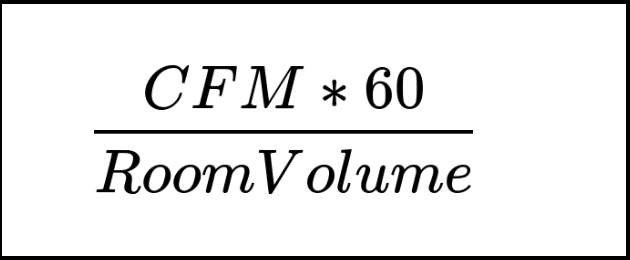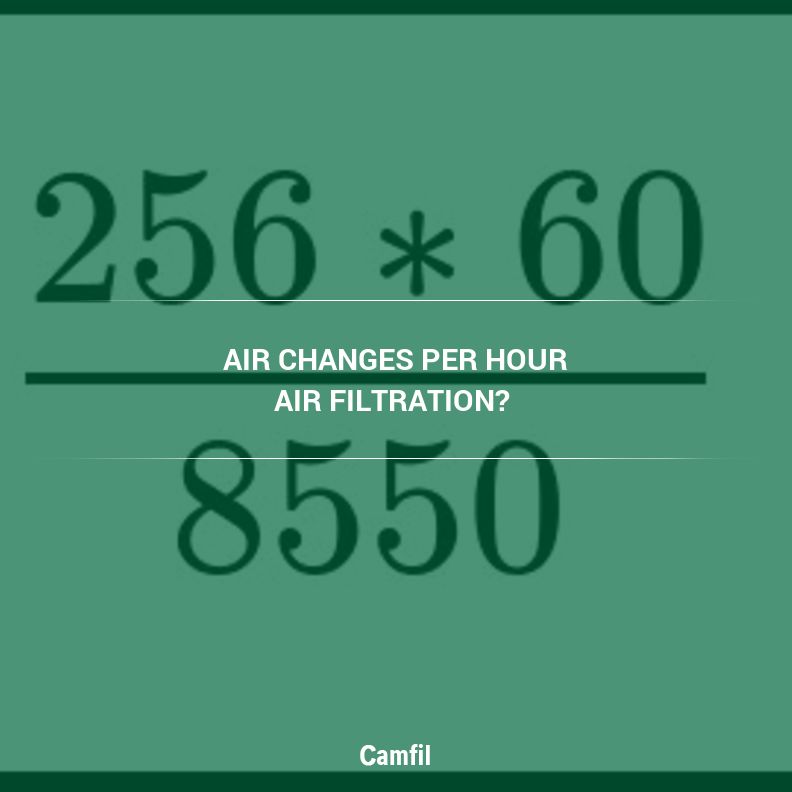In this article, air filtration experts from Camfil explain the importance of air ventilation within a room and how to calculate air changes per hour (ACH).
What Does Air Changes Per Hour (ACH) Mean in Air Filtration?
Air changes per hour, which is often abbreviated as ACH, is a calculation of how many times per hour the entire volume of air in a given space is replaced with supply and/or recirculated air. It is also sometimes referred to as “air change rate” or “air exchange rate.”
Why Do You Need to Calculate ACH?
Air changes per hour are important in determining if a space is getting adequate ventilation. Additionally, if you have chosen to implement air purifiers to improve air quality and lower the risk of COVID-19, ACH will help you determine which devices are appropriate for your application, as well as how many you need.
Ventilation is important for the indoor air quality (IAQ) inside a building. Improper ventilation can lead to a buildup of pollutants in indoor spaces, which is detrimental to the health of building inhabitants. According to the EPA (1), negative health effects of poor indoor air quality include:
- Irritation of the eyes, nose, and throat.
- Headaches, dizziness, and fatigue.
- Respiratory diseases, heart disease, and cancer.
Polluted air also leads to moodiness and decreased productivity for employees and reduced learning for students in school.
Additionally, the EPA asserts that increasing ventilation is an important strategy for decreasing the spread of COVID-19 in public spaces (2).
What Is the Formula for Calculating Air Changes per Hour?
To calculate air changes per hour, you will need to find two numbers.
CFM – First, the volume of air in CFM (cubic feet per minute) currently delivered to the room in question by the building’s air handling unit or when evaluating an air purifier, the CFM of the unit with the air filters installed.
ROOM VOLUME – Secondly, you will need to find the volume of the room in cubic feet, which is calculated by finding the height, length, and width of the room in feet and multiplying these numbers together.
From there, the calculation to find air changes per hour is simple:

- Multiply the CFM by 60. This number will tell you how many cubic feet of air your device moves per hour.
- Divide the number you get by the room’s volume in cubic feet. You now have a number telling you how many times per hour the device moves the total volume of the room. This number is your air changes per hour, or ACH.
Related video: What Size Air Cleaning Unit For Your Office? with Camfil’s Matthew Crouch
ACH Example Calculation
Let’s look at an example of this calculation in action.
For this example, we’ll be calculating how many air changes per hour a premium air purifier can deliver in a classroom.
An average U.S. elementary school classroom is recommended to be a minimum 900 square feet (2). In New Jersey, classrooms must have an average ceiling height of 9.5 feet (3). The volume of a classroom with these dimensions would be 8550 cubic feet.
Camfil’s City M air purifier circulates air through its certified HEPA filters at 256 CFM.
Therefore, ACH would be calculated as follows:
The City M air purifier would deliver an additional 1.8 air changes per hour to a classroom with these dimensions.
ASHRAE recommends six air changes per hour for classrooms. Measuring the actual ACH delivered by the building’s HVAC system to individual classrooms may require an HVAC professional with airflow measurement equipment. Once you have that figure, it is a simple calculation to determine how many air purifiers are required to make up the difference and achieve the recommended ACH for the classroom.

For guidance in determining the correct air filtration solutions for your situation, contact your local Camfil representative.
About Camfil Clean Air Solutions
For more than half a century, Camfil has been helping people breathe cleaner air. As a leading manufacturer of premium clean air solutions, we provide commercial and industrial systems for air filtration and air pollution control that improve worker and equipment productivity, minimize energy use, and benefit human health and the environment. We firmly believe that the best solutions for our customers are the best solutions for our planet, too. That’s why every step of the way – from design to delivery and across the product life cycle – we consider the impact of what we do on people and on the world around us. Through a fresh approach to problem-solving, innovative design, precise process control, and a strong customer focus we aim to conserve more, use less and find better ways – so we can all breathe easier.
The Camfil Group is headquartered in Stockholm, Sweden, and has 33 manufacturing sites, six R&D centers, local sales offices in 30 countries, and about 4,800 employees and growing. We proudly serve and support customers in a wide variety of industries and in communities across the world. To discover how Camfil can help you to protect people, processes and the environment, visit us at www.camfil.com/en-us/.
##
Sources:
- https://www.epa.gov/report-environment/indoor-air-quality
- https://www.epa.gov/coronavirus/ventilation-and-coronavirus-covid-19
- https://www.scarsdaleschools.k12.ny.us/cms/lib/NY01001205/Centricity/Domain/1105/2014-11-19%20Meeting%20of%20Greenacres%20Building%20Committee%20Meeting%20Handout%203%20-%20Classroom%20Size%20Standards.pdf
- https://www.state.nj.us/education/code/current/title6a/chap13.pdf
- https://www.ashrae.org/file%20library/technical%20resources/covid-19/ashrae-reopening-schools-and-universities-c19-guidance.pdf
The post How to Calculate Air Changes Per Hour appeared first on Air Filters for Clean Air.

